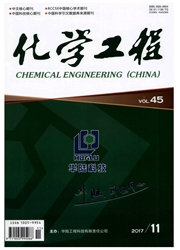

 中文摘要:
中文摘要:
研究了分置式膜反应器中TS-1催化苯酚羟基化反应的稳定性。膜反应器系统可连续运行20h以上,苯酚转化率、苯二酚选择性分别保持在11%,95%左右,膜过滤阻力逐渐增加。采用系列技术对使用前后的TS-1催化剂及陶瓷膜进行了表征。场发射扫描电子显微镜显示使用后的TS-1催化剂团聚加重,紫外可见分光光谱、红外光谱、N2吸附-脱附、热质量损失分析结果表明使用后TS-1催化剂的表面及孔道内存在有机物;X射线衍射结果表明:使用后TS—I催化剂的骨架钛有流失,二者共同造成TS-1催化剂失活,使反应初期苯酚转化率下降。将使用后的TS-1催化剂在600℃下锻烧6h进行再生,在苯酚羟基化反应中考察其催化性能,并与新鲜及使用后TS-1催化剂的催化性能进行比较。高温煅烧再生后TS-1催化剂的活性略有提高,但仍低于新鲜催化剂。场发射扫描电子显微镜分析结果显示,使用后陶瓷膜表面吸附-层由TS-1催化剂与有机物组成的滤饼层,是导致膜过滤阻力上升的主要原因。酸碱清洗可恢复陶瓷膜通量,反应过程中陶瓷膜保持良好的结构稳定性。
 英文摘要:
英文摘要:
The stability of continuous phenol hydroxylation over ultrafine TS-1 in a side-stream membrane reactor was investigated. The membrane reactor system could be continuously operated over 20 h. The phenol conversion and dihydroxybenzene selectivity remained stable at about 11% and 95%, respectively. The filtration resistance increased through the operation process. The fresh and used TS-1 catalysts and ceramic membranes were characterized by different methods. The results of field emission scanning electron microscopy (FESEM) show more aggregation of used TS-1 catalysts than that of fresh ones. It demonstrates that some organic matters exist on the surface and in the channels of used TS-1 catalysts by the results of ultraviolet-visible spectroscopy (UV-vis), Fourier transform infrared spectroscopy (FF-IR), N2 adsorption-desorption and thermogravimetry (TG). The results of X-ray diffraction (XRD) indicate that the content of titanium in the framework of used TS-1 catalysts is partly lost. Both of them together cause the deactivation
 同期刊论文项目
同期刊论文项目
 同项目期刊论文
同项目期刊论文
 Facile fabrication of porous ZnO by thermal treatment of zeolitic imidazolate framework-8 and its ph
Facile fabrication of porous ZnO by thermal treatment of zeolitic imidazolate framework-8 and its ph Preparation of palladium nanoparticles deposited on a silanized hollow fiber ceramic membrane suppor
Preparation of palladium nanoparticles deposited on a silanized hollow fiber ceramic membrane suppor Synthesis of Pd@ZIF-8 via an assembly method: Influence of the molar ratios of Pd/Zn2+ and 2-methyli
Synthesis of Pd@ZIF-8 via an assembly method: Influence of the molar ratios of Pd/Zn2+ and 2-methyli Preparation and Characterization of SiC Whisker-Reinforced SiC Porous Ceramics for Hot Gas Filtratio
Preparation and Characterization of SiC Whisker-Reinforced SiC Porous Ceramics for Hot Gas Filtratio Enhanced Catalytic Properties of Palladium Nanoparticles Deposited on a Silanized Ceramic Membrane S
Enhanced Catalytic Properties of Palladium Nanoparticles Deposited on a Silanized Ceramic Membrane S Fabrication of ceramic membranes with controllable surface roughness and their applications in oil/w
Fabrication of ceramic membranes with controllable surface roughness and their applications in oil/w Application of ceramic membranes in the treatment of oilfield-produced water: Effects of polyacrylam
Application of ceramic membranes in the treatment of oilfield-produced water: Effects of polyacrylam Insights into membrane fouling of a side-stream ceramic membrane reactor for phenol hydroxylation ov
Insights into membrane fouling of a side-stream ceramic membrane reactor for phenol hydroxylation ov Catalytic activity of palladium nanoparticles immobilized on an Amino-functionalized ceramic membran
Catalytic activity of palladium nanoparticles immobilized on an Amino-functionalized ceramic membran One-stepContinuous Phenol Synthesis Technology vi a Selective Hydroxylation of Benzeneover Ultrafine
One-stepContinuous Phenol Synthesis Technology vi a Selective Hydroxylation of Benzeneover Ultrafine Cleaning ceramic membranes used in treating desizing wastewater with a complex-surfactant SDBS-assis
Cleaning ceramic membranes used in treating desizing wastewater with a complex-surfactant SDBS-assis Enhanced catalytic properties of Pd nanoparticles by their deposition on ZnO-coated ceramic membrane
Enhanced catalytic properties of Pd nanoparticles by their deposition on ZnO-coated ceramic membrane One-step semi-continuous cyclohexanone production via hydrogenation of phenol in a submerged ceramic
One-step semi-continuous cyclohexanone production via hydrogenation of phenol in a submerged ceramic Palladium nanoparticles supported on a two-dimensional layered zeolitic imidazolate framework-L as a
Palladium nanoparticles supported on a two-dimensional layered zeolitic imidazolate framework-L as a Unusual Air Filters with Ultrahigh Efficiency and Antibacterial Functionality Enabled by ZnO Nanorod
Unusual Air Filters with Ultrahigh Efficiency and Antibacterial Functionality Enabled by ZnO Nanorod 期刊信息
期刊信息
